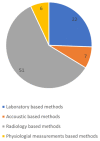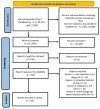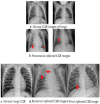Current Diagnostic Techniques for Pneumonia: A Scoping Review
- PMID: 39001069
- PMCID: PMC11244398
- DOI: 10.3390/s24134291
Current Diagnostic Techniques for Pneumonia: A Scoping Review
Abstract
Community-acquired pneumonia is one of the most lethal infectious diseases, especially for infants and the elderly. Given the variety of causative agents, the accurate early detection of pneumonia is an active research area. To the best of our knowledge, scoping reviews on diagnostic techniques for pneumonia are lacking. In this scoping review, three major electronic databases were searched and the resulting research was screened. We categorized these diagnostic techniques into four classes (i.e., lab-based methods, imaging-based techniques, acoustic-based techniques, and physiological-measurement-based techniques) and summarized their recent applications. Major research has been skewed towards imaging-based techniques, especially after COVID-19. Currently, chest X-rays and blood tests are the most common tools in the clinical setting to establish a diagnosis; however, there is a need to look for safe, non-invasive, and more rapid techniques for diagnosis. Recently, some non-invasive techniques based on wearable sensors achieved reasonable diagnostic accuracy that could open a new chapter for future applications. Consequently, further research and technology development are still needed for pneumonia diagnosis using non-invasive physiological parameters to attain a better point of care for pneumonia patients.
Keywords: COVID-19; community-acquired pneumonia; diagnostic radiography; medical diagnosis; non-invasive measurements.
Conflict of interest statement
The authors declare no conflicts of interest.
Figures












Similar articles
-
Pneumonia detection in chest X-ray images using an ensemble of deep learning models.PLoS One. 2021 Sep 7;16(9):e0256630. doi: 10.1371/journal.pone.0256630. eCollection 2021. PLoS One. 2021. PMID: 34492046 Free PMC article.
-
Thoracic imaging tests for the diagnosis of COVID-19.Cochrane Database Syst Rev. 2020 Sep 30;9:CD013639. doi: 10.1002/14651858.CD013639.pub2. Cochrane Database Syst Rev. 2020. Update in: Cochrane Database Syst Rev. 2020 Nov 26;11:CD013639. doi: 10.1002/14651858.CD013639.pub3. PMID: 32997361 Updated.
-
Multicenter evaluation of four immunoassays for the performance of early diagnosis of COVID-19 and assessment of antibody responses of patients with pneumonia in Taiwan.J Microbiol Immunol Infect. 2021 Oct;54(5):816-829. doi: 10.1016/j.jmii.2021.02.003. Epub 2021 Feb 23. J Microbiol Immunol Infect. 2021. PMID: 33676864 Free PMC article.
-
Universal screening for SARS-CoV-2 infection: a rapid review.Cochrane Database Syst Rev. 2020 Sep 15;9(9):CD013718. doi: 10.1002/14651858.CD013718. Cochrane Database Syst Rev. 2020. PMID: 33502003 Free PMC article.
-
Diagnosing COVID-19 in the Emergency Department: A Scoping Review of Clinical Examinations, Laboratory Tests, Imaging Accuracy, and Biases.Acad Emerg Med. 2020 Aug;27(8):653-670. doi: 10.1111/acem.14048. Epub 2020 Jul 26. Acad Emerg Med. 2020. PMID: 32542934 Free PMC article.
Cited by
-
Rapid, season-specific PCR testing versus traditional diagnostics for pneumonia in the emergency department.BMC Pulm Med. 2025 Aug 2;25(1):372. doi: 10.1186/s12890-025-03843-2. BMC Pulm Med. 2025. PMID: 40753203 Free PMC article.
References
-
- Mathers C., Stevens G., Hogan D., Mahanani W.R., Ho J. Disease Control Priorities: Improving Health and Reducing Poverty. 3rd ed. Volume 9. The World Bank; Washington, DC, USA: 2017. Global and Regional Causes of Death: Patterns and Trends, 2000–2015; pp. 69–104. - DOI
-
- McAllister D.A., Liu L., Shi T., Chu Y., Reed C., Burrows J., Adeloye D., Rudan I., Black R.E., Campbell H., et al. Global, regional, and national estimates of pneumonia morbidity and mortality in children younger than 5 years between 2000 and 2015: A systematic analysis. Lancet Glob. Health. 2019;7:e47–e57. doi: 10.1016/S2214-109X(18)30408-X. - DOI - PMC - PubMed
-
- CME Info—Child Mortality Estimates. [(accessed on 22 August 2020)]. Available online: https://childmortality.org/
Publication types
MeSH terms
Grants and funding
LinkOut - more resources
Full Text Sources
Medical
Miscellaneous

